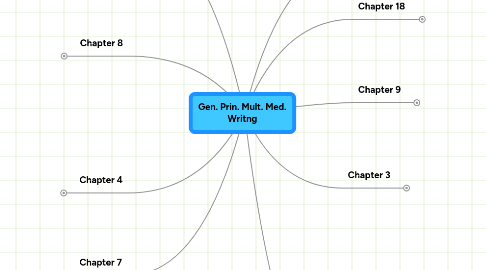
1. Chapter 1
1.1. Tech/Pro Communication
1.2. Characterized as
1.3. Producing Tech/Pro Comm.
1.4. Workplace Problems/Rehtorical Problems
1.5. PSA
1.6. Various kinds of Doc.
1.7. New node
2. Chapter 2
2.1. Workplace problems
2.2. Rhetorical problems
2.3. Workplace writers
2.4. Exigency and Impetus
2.5. Purposes of Ducuments
2.6. Rhetorical Thinking
2.7. Audiences
2.8. Expectations and Attitudes
2.9. Doc. used in diff. ways
2.10. Writers Credibility
2.11. Various Contexts and Contraints
2.12. Writers Meet Audiences Needs
2.13. Multi Audiences/Same Doc.
3. Chapter 3
3.1. Word Processors
3.2. Presentation Software
3.3. New node
3.4. Graphics and Imaging Software
3.5. Web-Authoring Software
3.6. Desktop Publishing Software
3.7. Help and e-learning
3.8. Single-Sourcing Programs
3.9. Technology and Collaboration
3.10. Internet Increases Efficiency
3.11. Technical Communications
3.12. Instant Messaging
3.13. Wireless Messaging
3.14. Video Conferencing
3.15. Future Workplace Writing
4. Chapter 4
4.1. Ethics
4.2. Three Perspectives
4.3. Ethics and the Law
4.4. Ethical Choices
4.5. Widespread Circulation
4.6. Editing and Revising
4.7. Code of Ethics
4.8. Ethics and Technology
4.9. Environmental Ethics
4.10. Deceptive Language
4.11. Plagiarism
4.12. Confirm all Info.
5. Chapter 5
5.1. Transnationl and Transcultural
5.2. Account for Nonnative speakers
5.3. Analyze transnational and transcultural audiences.
5.4. Learn about target language
5.5. Identify official national language
5.6. Language of world commerce
5.7. Language L/R directional flow
5.8. Level of technology in target countries
5.9. Machine translation software
5.10. Educational systems and approaches
5.11. Differences in laws and politics in target countries
5.12. Economic factors and perceptions
5.13. Religion in aspects of cultural life
5.14. Avoid stereotyping
5.15. Prepare doc. for translation
5.16. Localization, Internationalization and Globalization of Doc.
6. Chapter 7
6.1. Predrafting Straegies
6.2. Doc. purpose determines organization
6.2.1. Audience
6.2.2. Logic
6.2.3. Ethics
6.3. Organizational Strategies
6.3.1. Sequential
6.3.2. Chronological
6.3.3. Order of Importance
6.3.4. General/Specific
6.3.5. Division
6.3.6. Classification
6.3.7. Cause and effect
6.3.8. Comparison/Contrast
6.3.9. Spatial
6.4. Tech. Doc. 3 parts
6.4.1. front matter
6.4.2. body
6.4.3. end matter
6.5. First write the body
6.5.1. Procedures
6.5.2. Data
6.5.3. Steps
6.6. Conclusion
6.6.1. Closure
6.6.2. Summarization
6.6.3. Analytic Predictions
6.6.4. Recommendations
6.7. Introduction
6.7.1. Purpose/objective
6.7.2. Scope
6.7.3. Problem Identification
6.8. Web page Introduction
6.9. Templates and Wizards
7. Chapter 18
7.1. Technical Instructions direct audience
7.1.1. put something together
7.1.2. repair an object
7.1.3. operate or install a device
7.1.4. maintain a product
7.2. Numerous Elements
7.3. Title and Title Image
7.4. Byline
7.5. Date
7.6. Introduction
7.7. Alerts identify
7.7.1. dangers
7.7.2. warnings
7.7.3. cautions
7.7.4. notes
7.8. Equipment or Tool List
7.9. Parts List
7.10. Steps
7.10.1. Number each step
7.10.2. perform all steps as drafted
7.10.3. begin each step with a verb
7.10.4. Use positive commands
7.10.5. Avoid highly condensed language
7.10.6. One action per step
